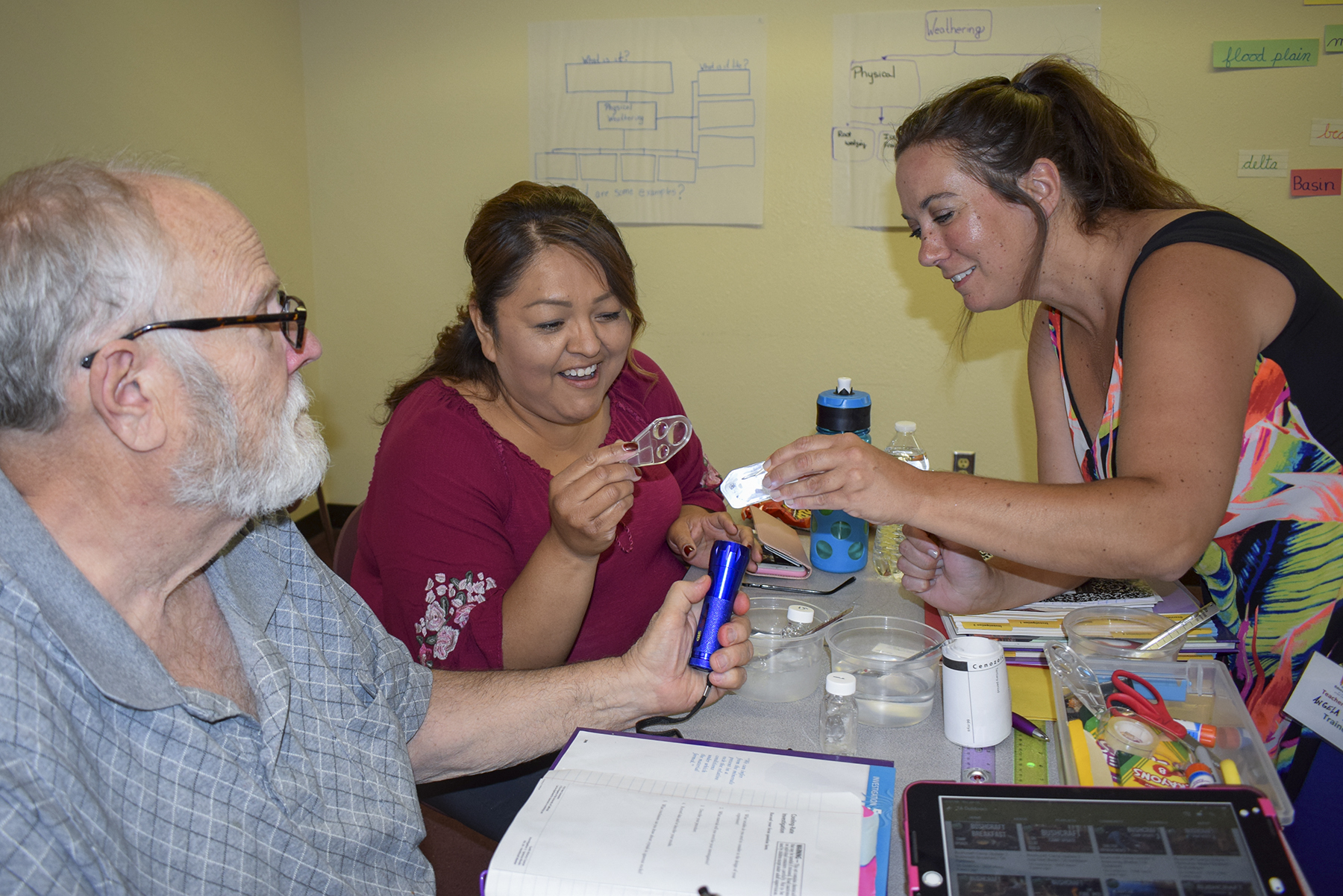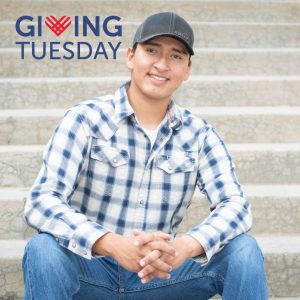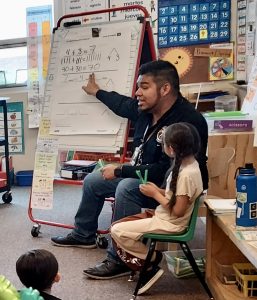Teachers are anything but sedentary during the LANL Foundation’s Inquiry Science Education Consortium (ISEC) Summer Teachers’ Institute. As Terri Lindstrom, one of the Institute’s teacher trainers put it, “ISEC allows us to actually touch science.”
Kindergarten teachers start their lessons on motion with a warmup dance that puts them in motion. They later walk around campus looking for objects in motion and compare the effort required to do the hula hoop or skip rope. First grade teachers explore sound using a plastic cup, a rubber band and a tongue depressor. Second grade teachers explore the different sizes of rock materials with screens. Third grade teachers have some fun with water and magnets. Fourth grade teachers build a plateau of sand in a tray and drip water onto it to study erosion. Teachers in the fifth grade class learn how to make a solution and separate a mixture. The sixth grade group spends the entire training learning about Earth history including ice wedging and rock falls. These are just a few of the engaging lessons that the teachers experience in preparation to teach science in the coming school year.
Kindergarten teachers start their lessons on motion with a warmup dance that puts them in motion.
“We focus heavily on hands-on, inquiry science, where—as if they were students—the teachers get to touch things, do investigations and see phenomena,” said Doris Rivera, K-12 Professional Development Coordinator for the LANL Foundation. “This is their chance to get excited and frustrated and to think about the process from the perspective of the students.”
1st grade ISEC teachers explore “What Causes Sound” with a rubber band, popsicle stick and plastic cup.
Nearly 50 teachers attended a June training at Northern New Mexico College (NNMC) in Española and another 110 were at the July session at El Camino Real Academy in Santa Fe. Trainings last four days, with two devoted to learning physical science kits and two more spent with earth science kits. ISEC teachers receive a stipend for attending, and the LANL Foundation provides a hotel room for those traveling more than 60 miles.
The ISEC program is now in its 10th year. The curriculum modules were upgraded in 2016 giving ISEC K–6 teachers advanced knowledge of and training on the national Next Generation Science Standards, long before New Mexico decided to adopt its version called the NM STEM Ready! Science Standards. In 2016, all teachers in the program were introduced to the new materials and to the science and engineering practices, disciplinary core ideas and cross cutting concepts in NGSS during the Teachers’ Institute. Now, the summer professional development is for those who are new to the program or changing grade levels.
Teacher Trainer Javier Arellano coaches 5th grade teachers studying mixtures and solutions.
New Partnerships
Three new schools joined the program this year: San Ildefonso Day School, Te Tsu Geh Oweenge Day School and La Tierra Montessori School for the Arts and Sciences. With these additions in the 2019–2020 school year, a total of about 600 ISEC teachers will serve 12,000 students in 47 elementary schools across eight districts and in four Pueblos.
La Tierra Montessori has been in existence for 10 years as a K–6 grade State Charter School located on the Ohkay Owingeh Pueblo. Director Monique Garcia saw the ISEC program as a good fit to the school’s multi-sensory, child-centered approach to the development of academic, social-emotional and creative skills in its students.
“We are so very excited to be included in the LANL Foundation ISEC program,” said Garcia. “This program fits perfectly into our Montessori curriculum of exploration and experiential learning. I have worked with the LANL Foundation in former school districts, so I am really happy to have this newly founded collaboration.”
This is also the first year the LANL Foundation has partnered with Northern New Mexico College (NNMC) to hold a Teachers’ Institute on that campus.
“For the college, it’s a great opportunity because it brings teachers from Northern New Mexico,” said Dean Sandra Rodriguez.
For Rodriguez, one of the best aspects of the partnership is the opportunity for Alternative Licensure Programs (ALP) students to participate in the training. ALP participants already hold a degree but may have no background in teaching or science and want to enter the profession of education. ISEC training helps them gain experience to anticipate what an elementary science class will look like if they eventually teach in an ISEC school using inquiry methods.
Rodriguez was pleased with what she observed.
“You can hear the excitement, people talking, laughing,” Rodriguez said. “We’ve got a couple of our students that are part of the program right now, and one of them in particular, she’s beaming.
“Earlier, during the activity where they made the little parachutes, you could see all of the adults—they’re certainly not kids—coming up the stairs excited and laughing and pulling the parachutes down and throwing them. And the competition to see who made the best model was apparent, but it was also very lighthearted.”
Kindergarten Teacher Trainer Mary Shoemaker demonstrates her hula hoop skills The hula hoops are used in lessons on motion, as students compare the effort required for that activity to others, such as jumping rope.
The partnership with NNMC furthers the Foundation’s goal to expand partnerships, attract new teachers and support them through the development of their practice.
“It’s in our mission, and our vision is to make these partnerships and relationships grow,” Rivera said.
Local Teacher Trainers Lead the Way
Another element that makes the ISEC training so effective is that teachers are taught by their peers.
“We offer a train-the-trainer model, which means that the trainers here today are teachers who have experience teaching the kits to students in the classroom,” Rivera said. “They not only bring their knowledge, but they bring their experience of classroom management, tips and tricks and just good practice that they can offer the teachers.”
Teacher Trainers Deb Magaña and Bart Ramey with the 2nd grade ISEC class.
During this Teachers’ Institute, experienced trainers were paired with one or more trainers-in-training. The program builds on the LANL Foundation’s decision a few years ago to transition from bringing in outside trainers to building a pool of local experts.
“We want people doing the training who know our culture, who know our students, who know our communities where the students come from,” Rivera said. “Because Northern New Mexico is so unique, and getting a trainer from somewhere else is not the same as having been trained by someone you can actually text in the moment or go talk to about materials.”
Most of the trainers are members of the Teacher Leadership Cadre (or TLC as they are lovingly called), comprised of approximately 60 teachers. They provide “boots-on-the-ground” support for teachers in their schools and serve as liaisons between the LANL Foundation’s professional development team (led by a former teacher who understands the needs and challenges of local educators) and school administration. They receive a stipend for their participation and leadership throughout the year.
Teacher Trainer April Grant-Torrez (right) facilitates a “meaning making circle.”
“Facilitating leadership within our own schools is really important to us,” Rivera said. “And these are the experts.”
Terri Lindstrom, who teaches at Tierra Amarilla Elementary in the Chama Valley Independent Schools system, was a sixth grade trainer at NNMC. She stressed how much she learns from the teachers she trains.
“All of the teachers bring their experiences, so I’m learning from them. I leave a better teacher every time I teach the program,” Lindstrom said.
Teacher Trainer Terri Lindstrom assists a 6th grade teacher with identifying the properties of a rock specimen.
Pamela Gallegos was working with Lindstrom as a trainer-in-training. Gallegos teaches fifth grade James H. Rodriguez in the Española Valley Public School District but found valuable lessons from training in a sixth grade classroom.
“It’s helping me to see the connections between fifth and sixth, and things that I need to emphasize in fifth grade for them to be successful with the sixth grade kits,” Gallegos said.
The Teachers’ Perspectives
Teachers participating in the training develop confidence in their ability to teach science and new methods of working with students. Kimberly Vigil, an ETS Fairview Elementary teacher in the Española Valley School District who served as an assistant at the NNMC training, has been an ISEC teacher trainer for several years. She likes ISEC’s inquiry-based focus.
“As a teacher, I’m more facilitating. When I teach science, I tell them, ‘Go ahead and put your scientist’s hat on,’” Vigil said.
Vigil also uses ISEC to teach math and English language arts (ELA).
“I think a lot of times for teachers there’s a notion that there just isn’t enough time for science. But I actually incorporate my science teaching into my ELA time, especially because it does provide a lot of informational text, which is a huge piece of where kids tend to be lacking in terms of meeting the common core standards.”
Kimberly Vigil, who has been an ISEC Teacher/Trainer for seven years, served as a Trainer Assistant at the Northern New Mexico College ISEC training.
ISEC is also a program that teachers grow with.
“Each time I do an activity I can go deeper, so I’m not just teaching surface level like I did the first year, I’m really understanding the content more and more,” Lindstrom said.
Janan Talmadge, who teaches at Velarde Elementary in the Española Valley School District was in her first year as a teacher trainer with the fifth grade curriculum. ISEC helped her discover a love of science.
“With science, it’s like discovering something for the first time. What is science, really? Science is inquiry, science is wonder, science is, ‘Oh, my gosh, I’ve just discovered that,’” Talmadge said. “ISEC just reinforces that love of science: to always have that inquiry, to always inspire kids to wonder why, how, what if?”
Bobby Richardson has been teaching the third grade kit at Peñasco Elementary but was at the NNMC training to learn the 2nd grade kit for his new grade assignment. What sets the ISEC method apart for him is, “It’s a lot louder and it’s a lot messier, but it is beneficial for the kids. They get to stand up and walk around. And it’s project-based, so they work with manipulatives, and it gives an opportunity for your quiet kids to come out and share what they’ve learned with each other.”
Making Sense of it All
During each hands-on lesson, students participate in data collection, writing observations and drawing models in their science notebooks. Lessons end in a Meaning Making Circle where the students share what they have experienced. Conversations are driven by them, not the teacher. These practices not only deepen understanding of scientific phenomena and increase their ability to remember the information when they are tested but help extend ISEC’s impact beyond science.
First grade Teache Ttrainers Madelin Means (left) and Rita Rios Baca (center) take turns explaining how to set up journals for a lesson on sound.
“It’s through the notebooking and the data collection that this becomes a literacy-rich program,” Rivera said. “There’s math and science, history, literacy, reading and writing. It’s a cross-content area program. Instead of one teacher giving them all the knowledge, they’re working together to share the knowledge. And they learn so much more from that,” Rivera said.
Lindstrom loves the impact Meaning Making Circles have on students’ discourse skills. She now uses them in her main discipline, math.
“If somebody has a misconception they’ve learned to say, “I respectfully disagree with you,” and then they clarify the point. Or they’ll ask each other questions,” Lindstrom said. “I think this program is really teaching them how to talk to one another and know that it’s okay to disagree, but they can do it in a respectful way.”
Support in the Classroom
The LANL Foundation provides free kits to participating schools and supports ISEC in the classroom with direct assistance for the teachers as needed. Kits include all of the needed inquiry materials and standards-aligned curriculum delivered right to each school. Then at the end of the semester, kits are picked up and restocked before going on to the next classroom.
“We always want to emphasize we’re here for support. We’re here for you teachers and principals,” Rivera said.
Talmadge praised those efforts.
“If we have a question about something, they’re right there, same day. A lot of times within five minutes they’ll get you the response you’re looking for,” Talmadge said. “The support system is so immediate and constant that it really supports me as an educator and helps me facilitate that instruction to my students.”
—Story and photos by Arin McKenna
Doris Rivera, Professional Development Coordinator at the K-12 program at the LANL Foundation conducts the orientation at the NNMC Inquiry Science Education Consortium (ISEC) Summer Teachers Institute.
Teacher Trainer Laura LaRue explains how kindergarten teachers can use the Weather Buddy, whose clothing changes based on the temperature.
2nd grade Teacher Trainer Deb Magaña explains different types of matter.
4th grade teachers prepare an experiment in erosion.
3rd grade Teacher Trainer Liz Lopez, asks teachers how their experiment is progressing.
5th grade Teacher Trainer Janan Talmadge points to the question the class will try to answer through that lesson’s hands on exploration.
Teacher Trainer Melissa Gaillour drips water onto a ridge of sand as 4th grade teachers observe the effects of erosion.
The 4th grade classroom was adorned with bright signage depicting the topics the “class” would be studying.



